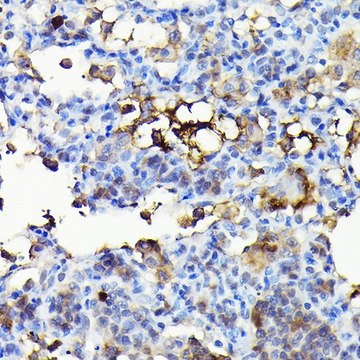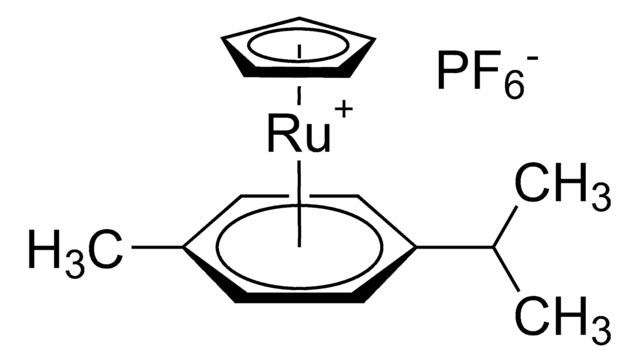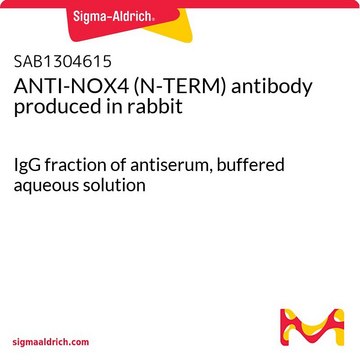ABC459
Anti-NOX4 Antibody
from rabbit
Synonym(s):
NADPH oxidase 4, Kidney oxidase-1, KOX-1, Kidney superoxide-producing NADPH oxidase, Renal NAD(P)H-oxidase
About This Item
Recommended Products
biological source
rabbit
Quality Level
antibody form
purified antibody
antibody product type
primary antibodies
clone
polyclonal
species reactivity
human, mouse
species reactivity (predicted by homology)
rat (based on 100% sequence homology)
technique(s)
immunocytochemistry: suitable
immunohistochemistry: suitable
NCBI accession no.
UniProt accession no.
shipped in
wet ice
target post-translational modification
unmodified
Gene Information
human ... NOX4(50507)
General description
Immunogen
Application
Immunohistochemistry Analysis:: A representative lot detected NOX4 in mouse liver tissue (I. Fabregat, IDIBELL, Barcelona, Spain).
Immunocytochemistry Analysis: A representative lot detected NOX4 in Hep3B cells (Esther Bertran, IDIBELL, Barcelona, Spain).
Immunohistochemistry Analysis: A representative lot detected NOX4 in mouse liver tissues expressing wildtype Mdr2/p19, or knockout Mdr2 ARF or knockout Stat3/Mdr2 (Sancho, P. et al. (2012). PLoS One. 7(9):e45285.).
Apoptosis & Cancer
Apoptosis - Additional
Quality
Immunohistochemistry Analysis: A 1:50 dilution of this antibody detected NOX4 in human kidney tissue.
Target description
Physical form
Storage and Stability
Other Notes
Disclaimer
Not finding the right product?
Try our Product Selector Tool.
Storage Class Code
12 - Non Combustible Liquids
WGK
WGK 1
Flash Point(F)
Not applicable
Flash Point(C)
Not applicable
Certificates of Analysis (COA)
Search for Certificates of Analysis (COA) by entering the products Lot/Batch Number. Lot and Batch Numbers can be found on a product’s label following the words ‘Lot’ or ‘Batch’.
Already Own This Product?
Find documentation for the products that you have recently purchased in the Document Library.
Our team of scientists has experience in all areas of research including Life Science, Material Science, Chemical Synthesis, Chromatography, Analytical and many others.
Contact Technical Service![RuCl(p-cymene)[(S,S)-Ts-DPEN]](/deepweb/assets/sigmaaldrich/product/structures/596/849/f8e3d2d8-a02e-430e-b0ed-c208cea3a6fb/640/f8e3d2d8-a02e-430e-b0ed-c208cea3a6fb.png)
![RuCl(p-cymene)[(R,R)-Ts-DPEN]](/deepweb/assets/sigmaaldrich/product/structures/161/670/212e6eb8-dce1-4397-a5ef-3e2e3a296e8c/640/212e6eb8-dce1-4397-a5ef-3e2e3a296e8c.png)

![RuCl2[(R)−DM−BINAP][(R)−DAIPEN]](/deepweb/assets/sigmaaldrich/product/structures/355/628/d82e5e5d-23fd-468a-87ca-db4c45677898/640/d82e5e5d-23fd-468a-87ca-db4c45677898.png)

 90%](/deepweb/assets/sigmaaldrich/product/structures/688/786/21c1946c-cdc5-40d4-bce5-5b82b1239504/640/21c1946c-cdc5-40d4-bce5-5b82b1239504.png)
 95%](/deepweb/assets/sigmaaldrich/product/structures/151/609/eeb99dc1-9ef2-49d8-b255-6b5e2519fee1/640/eeb99dc1-9ef2-49d8-b255-6b5e2519fee1.png)

